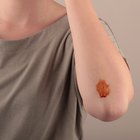Lidocaine is a topical solution used to block the transmission of pain signals from the nerve endings in the skin to the brain, according to the Mayo Clinic. It can be used to treat the discomforts shingles, vaccines or even laser hair removal. There are multiple forms of lidocaine including creams, foams, gels, sprays or lotions. Lidocaine is a medical-strength drug and should be used under close medical supervision. Proper use of lidocaine can reduce or even eliminate the pain associated with laser hair removal, but improper use can result in serious health problems, or even death, according to the FDA.
Determine whether your laser hair removal technician will apply the solution before your scheduled appointment, or if you are to apply it yourself.
Apply the lidocaine solution to the area to be treated 20 to 30 minutes before your appointment. Spread a small layer across your skin. Avoid any areas of broken skin or irritation. If the laser hair removal facility applies the lidocaine for you, arrive at your appointment at least 30 to 40 minutes early, unless otherwise instructed.
Proceed with the laser treatment once the lidocaine has taken effect. This can occur as soon as 15 to 20 minutes after application, but it may take longer.
Related Articles

How to Obtain a Duplicate Birth ...

Aesthetic Laser Requirements in Ohio

How to Stop AARP Mail

How to Change My Last Name for Free

How to Treat Eyebrow Wax Burns

Review of New-Skin Scar Therapy

How to Pan Cook a Sirloin to Medium-Well

How to Substitute Mayonnaise for Sour ...

How to Change the Battery in a Luminox ...

How to Get Married by the Justice of ...

How to Get Rid of Bumps From Plucking

How to Remove Betadine From the Skin

How to Get Rid of a Tattoo Scab

Dangers of Spray on Tan

Veet Side Effects

How to Unclump Eyelashes

How to Use Vaniqa Cream

How to Pipe with Whipped Cream

How to Clean Scuffed Up Rain Boots

How to Undo a Divorce
References
Tips
- Use the lowest concentration of lidocaine available to you.
Warnings
- Do not proceed with the laser treatment if you notice redness, itching or any other uncomfortable sensations at the site of application.
- If you have ever had an allergy to lidocaine or similar products do not use topical lidocaine.
- The FDA warns consumers not to use large quantities of the anesthetic, including applying a small amount to a large area of skin. Do not wrap your treated skin with plastic wrap or any other type of cover. Do not apply a heating pad to any skin treated with lidocaine.
Writer Bio
Stephen Harding has been writing since 2009, with work on eHow and LIVESTRONG.COM. A U.S. Marine captain, he has military, operations and leadership experience. He holds a Bachelor of Business Administration in marketing from the University of Central Arkansas, is a Six Sigma Green Belt and a Development Dimensions International Targeted Selection Interviewer. He is completing an MBA at the University of Iowa.